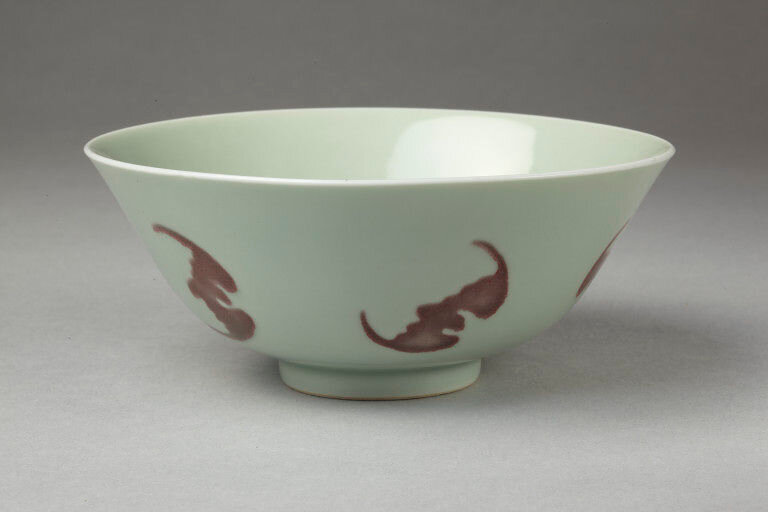A pair of copper-red 'wufu' bowls, Yongzheng marks and period (1723-1735)
Lot 142. A pair of copper-red 'wufu' bowls, Yongzheng marks and period (1723-1735). Diameter 6 in., 15.3 cm. Estimate 120,000 — 150,000. Lot sold 125,000 USD. © Sotheby's.
each delicately potted with deep curved sides rising from a straight foot to a gently flared rim, the exterior boldly painted with four bats swooping and soaring in copper-red silhouettes, the intensity of the red deftly shifting from deep crimson to a pale pinkish-gray at the wing tips, all reserved on a white ground, the interior center with a further bat in flight, the base with a six-character mark within a double circle in underglaze blue (2).
Note: Designs created through red-glaze silhouettes originated in the early Ming dynasty and are best known from the Xuande (1426-35) period, but the technique had already been developed during the Yongle reign (1403-24), when silhouettes of animals and fish were used in combination with underglaze-blue designs; for an example excavated from the late Yongle stratum of the Ming imperial kiln site, see Imperial Porcelain of the Yongle and Xuande Periods Excavated from the Site of the Ming Imperial Factory at Jingdezhen, Hong Kong Museum of Art, Hong Kong, 1989, cat. no. 38 and a Xuande period example recovered from the Xuande stratum of the Ming imperial kiln site at Jingdezhen and included in the exhibition Jingdezhen chutu Ming Xuande guanyao ciqi [Xuande Imperial Porcelain Excavated at Jingdezhen], Chang Foundation, Taipei, 1998, cat. no. 101-2.
Notoriously difficult to achieve, copper-red glazes had been largely abandoned at Jingdezhen since the early Ming dynasty and were revived during the Kangxi reign. Recent research by Peter Lam and other leading scholars indicate that the inspiration to revisit the celebrated but technically challenging pigment occurred during the early years of the Kangxi period under the direction of Zang Yingxuan, who was sent to Jingdezhen in 1681 to oversee the rebuilding of the kilns and serve as imperial supervisor. It was in these early years of the Qing dynasty that a series of copper-red mythical beasts appear, their abstracted rich-red forms boldly contrasting with white porcelain body covered with a pale blue-tinged transparent glaze.
By the Yongzheng period, the technique had been perfected and achieved its finest form of expression with the crimson-red glaze silhouettes of fish, pomegranates and most rare of all, bats, appearing on bowls, stem bowls and dishes, and bearing imperial reign marks. This silhouette technique, which makes use of the copper-red glaze, possibly sandwiched between layers of clear glaze, is different from the more common method of painting designs in copper-red pigment directly onto the body before the glaze is applied. The present technique, if successfully handled, results in intensely red designs which do not allow for the rendering of detail and are best suited for silhouettes.
A nearly identical pair to the present example, from the Malcolm McDonald Collection, in the Oriental Museum, Durham University is illustrated in Ireneus László Legeza, A Descriptive and Illustrated Catalogue of the Malcolm McDonald Collection of Chinese Ceramics in the Gulbenkian Museum of Oriental Art and Archaeology School of Oriental Studies University of Durham, London, 1972, pl. LXXVIII, nos 218, 219. Another identical example is illustrated in Bo Gyllensvärd, Chinese Ceramics in the Carl Kempe Collection, Stockholm, 1964, pl., 788; and a bowl of similar palette and decoration was sold at Christie’s Hong Kong, 1st June 2011, lot 3527. Yongzheng mark and period bowls of this same pattern are also recorded with the copper-red decoration on a celadon-glazed ground, for example, the Baur Collection, Geneva has a bowl of this type illustrated in John Ayers, Chinese Ceramics in the Baur Collection, vol. 2, Geneva, 1999, pl. 199 and another is in the Victoria and Albert Museum, London and illustrated in John Ayers, Far Eastern Ceramics in the Victoria and Albert Museum, London, 1980, pl. 206.
Bowl, porcelain painted with five bats in copper-red with a celadon glazed ground, China, Qing dynasty, Yongzheng mark and period (1723-1735). Given by Mrs Julia C. Gulland, 590&A-1907. © Victoria and Albert Museum, London
Sotheby's. Important Chinese Art, New York, 12 sept. 2018, 10:30 AM

/https%3A%2F%2Fprofilepics.canalblog.com%2Fprofilepics%2F1%2F0%2F100183.jpg)
/https%3A%2F%2Fstorage.canalblog.com%2F03%2F02%2F119589%2F96711876_o.jpg)
/https%3A%2F%2Fstorage.canalblog.com%2F11%2F31%2F119589%2F94773502_o.jpg)
/https%3A%2F%2Fstorage.canalblog.com%2F20%2F83%2F119589%2F94772815_o.jpg)
/https%3A%2F%2Fstorage.canalblog.com%2F26%2F72%2F119589%2F75604929_o.jpg)
/https%3A%2F%2Fstorage.canalblog.com%2F59%2F60%2F119589%2F26458628_o.jpg)





/http%3A%2F%2Fstorage.canalblog.com%2F88%2F26%2F119589%2F129337200_o.jpg)
/http%3A%2F%2Fstorage.canalblog.com%2F51%2F59%2F119589%2F128976423_o.jpg)
/http%3A%2F%2Fstorage.canalblog.com%2F30%2F27%2F119589%2F128677718_o.jpg)